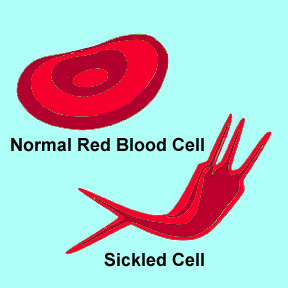By Susan Yeargin, PhD, ATC and Randy Eichner, M.D., FACSM
After birth every baby is tested for a wide variety of conditions and diseases. One of the tests looks for a condition called "Sickle Cell Trait." Ordinarily, a relatively benign condition, sickle cell trait can cause youth engaged in sustained, intense exercise to suffer a potentially life-threatening condition called exertional sickling.
What is sickle cell trait
Sickle cell trait is found in 1 in 12 African-Americans. It is also found in Caucasians, Mediterranean, Middle Eastern, and Central American children, but is rarer in these ethnicities (1 in 2,000 to 1 in 10,000 Caucasians).
Red blood cells carry oxygen through the bloodstream. Healthy red blood cells are round in shape. Red blood cells in children with sickle cell trait turn into a "sickle" instead of staying round after they release their oxygen, increasing the likelihood that they will get stuck to the walls of blood vessels. 
When children with sickle cell trait are exercising, there is the potential for the sickle cells to create a "log jam" in blood vessels and stop the blood flow. This can cause rapid muscle breakdown and potentially overwhelm the kidneys.
Exertional sickling signs and symptoms
Children who exercise intensely, particularly in the heat, can experience a condition called exertional sickling. This can commonly occur in organized sports as a result of:
- Low blood oxygen levels;
- Increased muscle heat; and/or
If your child has sickle cell trait, the signs and symptoms that he is experiencing sickling include:
- Cramping pain in legs or arms (not spasms)
- Legs feel "like jello"
- Fast breathing (but not wheezing, as in asthma)
- Collapsing suddenly during the practice or game, but can still talk
- Core temperature is slightly elevated.
If your child is experiencing headache, dizziness, or nausea, he is likely experiencing dehydration, not sickling.
Risk factors
-
Heat
- High intensity exercise with few rest intervals
Treatment
If you believe your child is experiencing exertional sickling during or after exercise, here's what to do:
- Remove the child from the activity
- Call 911 and explain that urgen care needed to prevent explosive rhabdomyolysis
- Make the child comfortable, including cooling for comfort
- Give her something to drink
Prevention
Exertional sickling collapse is an intensity syndrome. The common denominator is a "perfect storm" of irrational or unduly intense exercise, sustained for at least a few minutes; an intensity beyond the fitness level and/or physical limits of the athlete with sickle cell trait on that day in that setting.
It is therefore critical, if your child has sickle cell trait, that the following steps be taken to prevent exertional sickling.
- Make sure coaches and support staff are aware of your child's condition. The physician who performs your child's first pre-participation physical evaluation (PPE) should note Sickle Cell Trait on the form when clearing the child for sports.
- Educate yourself, your child, and the coaches about sickling, its signs and symptoms, and the danger intense exercise poses.
-
When your child is exercising in the heat:
-
the intensity of workouts should only be increased gradually to allow him to become acclimated to exercising in the heat
-
the tempo of practice should be slowed down
-
he should be allowed to set his own pace
-
he should be allowed longer and more frequent breaks
-
-
He should be excused from participating in intense conditioning drills such as timed miles, sprints, "gassers" (no all-out exertion lasting longer than 2 minutes)
- He should stop exercising immediately at the first indication that he is struggling during practice
-
Make sure he is well-hydrated
-
Make sure his asthma is controlled
- Keep him out of practice or play while he is sick with a cold, flu, or some other illness.
Dr. Susan Yeargin is MomsTeam's hydration expert and an Assistant Professor in the Athletic Training Department at the University of South Carolina. Dr. Randy Eichner is a retired physician and former team physician for the Oklahoma University football team and one of the leading experts on exertional sickling.








